国际贸易理论与政策试题
- 格式:doc
- 大小:65.25 KB
- 文档页数:5
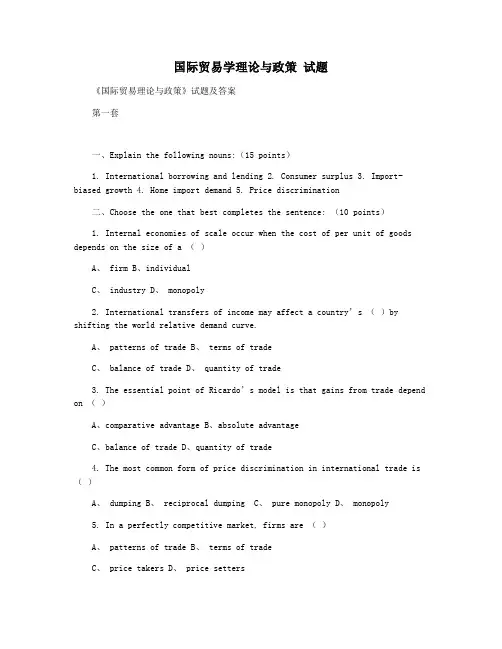
国际贸易学理论与政策试题《国际贸易理论与政策》试题及答案第一套一、Explain the following nouns:(15 points)1. International borrowing and lending2. Consumer surplus3. Import-biased growth4. Home import demand5. Price discrimination二、Choose the one that best completes the sentence: (10 points)1. Internal economies of scale occur when the cost of per unit of goods depends on the size of a ()A、 firmB、individualC、 industryD、 monopoly2. International transfers of income may affect a country’s ()by shifting the world relative demand curve.A、 patterns of tradeB、 terms of tradeC、 balance of tradeD、 quantity of trade3. The essential point of Ricardo’s model is that gains from trade depend on ()A、comparative advantageB、absolute advantageC、balance of tradeD、quantity of trade4. The most common form of price discrimination in international trade is ()A、 dumpingB、 reciprocal dumpingC、 pure monopolyD、 monopoly5. In a perfectly competitive market, firms are ()A、 patterns of tradeB、 terms of tradeC、 price takersD、 price setters三、Answer the following questions chiefly: (30 points)1. What does the relationship between MR and price depends on?2. Whatare the failings of the Recardian Model?3. How is trade based on external economies in its effects on national welfare?4. What benefits and costs does an export subsidy bring for the exporting country?5. In 1986, the price of oil on world markets dropped sharply. Since the UnitedStates is an oil-importing country, this was widely regarded as good forthe U.S. economy. Yet, in Texas and Louisiana 1986 was a year of economic decline. Why?6. What do factor movements include?四、Justify true or false: (10 points)1. International factor movements can sometimes substitute for trade. ()2. Economic growth means an inward shift in a country’s production possibilityfrontier. ()3. In reality, we can observe complete factor price equalization. ()4. Foreign tariffs are always bad for a country and foreign exportsubsidies always beneficial. ()5. The distinctive feature of direct foreign investment is that itinvolves only a transfer of resources. ()五、Calculate the following questions: (20 points)1、Home has 1200 units of labor available. It can produce two goods, and bananas. The unit labor requirement in apple production is 3, while in banana production it is 2.a、Graph Home’s production possibility frontier.b、What is the opportunity cost of apples in terms of bananas?c、 In the absence of trade, what would the price of apples in terms of bananas be?Why?2、The nation of American is “small,”unable to affect world prices. It imports peanuts at the price of $10 per bag. The demand curve is D=400-10P.The supply curve is S=50+5P.Determine the free trade equilibrium. Then calculate the following effects of an import quota that limits imports to 50 bags.a、 The increase in the domestic price.b、The quota rents.c、 The consumption distortion loss.d、The production distortion loss.六、Translate the following passage into Chinese: (15 points)1、As a country seeks to employ more labor on a given amount of land, it must move to increasingly labor-intensive techniques of production, and this will normally become increasingly difficult the further the substitution of labor for land goes.2、The fixed cost in a linear cost function gives rise to economies of scale, because the larger the firm’s output, the less is the fixed cost per unit.3、There is no good economic justification for regarding dumping as particularly harmful, but U.S. trade law prohibits foreign firms from dumping in our market and automatically imposes tariffs when such dumping is discovered.4、an economy’s productive capacity is described by its PPF, the differences in PPF bring out trade. Production possibilities determine a country’s RS. World equilibrium is determined by RDW and a RSW that is between the nations’ RS.5、International trade plays a crucial role: It makes it possible for each country to produce a restricted range of goods and to take advantage of economies of scale without sacrificing variety in consumption.答案一、Explain the following nouns: (15 points)1. International borrowing and lending can be viewed as a kind of internationaltrade, but one that involves trade of present consumption for future consumption rather than trade of one good for another.2. Consumer surplus is the difference between the price a consumeractually paysand the price he would have been willing to pay.3. Import-biased growth is the growth that biased toward the good a countryimports.4. Home import demand means that Home consumers demand is more than Homeproducers supply.5. In general, the practice of charging different customers different prices is calledprice discrimination.二、Choose the one that best completes the sentence: (10 points)A B A A C三、Answering the following questions chiefly: (30 points) 1、The relationship between MR and price depends on two things: Firstly, it depends on how much output the firm is already selling. Secondly, it depends on the slope of the demand curve.2、The failings of the Recardian Model:(1) It has neglected the effects of inter- national trade on the income distribution within countries, and predicted countries as a whole could always gain from trade. In fact, some organized political opposition is much more important than the gains from trade.(2) It predicts an extreme degree of specialization but not observed in the real world. (3) It has neglected trade system(4) It has not taken scale economy into the model, and this has weakened its explaining force on the large trade flows between apparently similar nations. (5) It has omitted the costs of labor movements among the industries.3、Trade based on external economies is ambiguous in its effects on national welfare. On one hand, it may make a country better off; on the other hand, it may also make a country worse off.4、In the exporting country, consumers lose, producers gain, and the government loses because it must expend money on the subsidy.5、Texas and Louisiana are states with large oil-producing sectors. The real wage of oil-producing factors of production in terms of other goods falls when the price of oil falls relative to the price of other goods. This was the source of economic decline in these states in 1986.6、Factor movements include labor migration, the transfer of capital via international borrowing and lending, and the subtle international linkages involved in the formation of multination corporations.四、Justify true or false: (10 points)? ? ? ? ?五、Calculate the following questions:(20 points)1、a、the apple400(1200/3)Home’s PPF600( 1200/2) the banana b、The opportunity cost of apples in terms of bananas is 3÷2=1.5.c、Labor mobility ensures a common wage in each sector and competition ensures the price of goods equals their cost of production. Thus, the relative price equals the relative costs, which equals the wage times the unit labor requirement for apples divided by the wage times the unit labor requirementfor bananas. Since wages are equal across sectors, the price ratio equals the ratio of the unit labor requirement, which is 3 apples per 2 bananas.2、At a price of $10 per bag of peanuts, American imports 200 bags of peanuts. A quota limiting the import of peanuts to 50 bags has the following effects: a、 The price of peanuts rises to $20 per bag.b、The quota rents are ($20-$10)×50=$500.c、 The consumption distortion loss is 5×100 bags×$10 per bag=$500.d、The production distortion loss is 5×50 bags×$10 per bag=$250.六、Translate the following passage into Chinese: (15 points)1. 一国要在给定土地上雇佣更多劳动力就必须移向劳动密集型技术的生产。
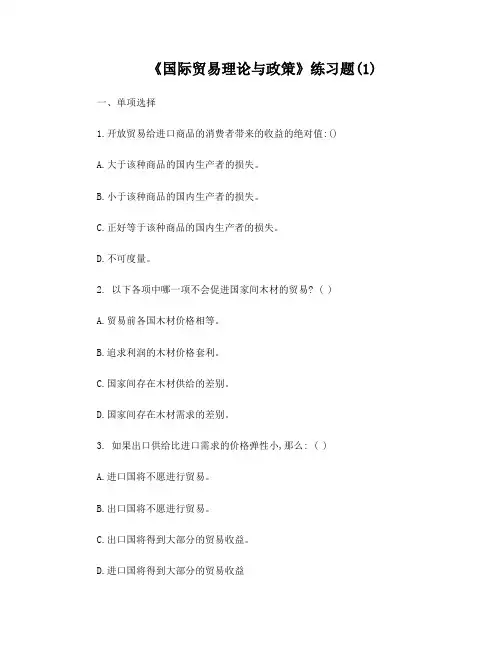
《国际贸易理论与政策》练习题(1)一、单项选择1.开放贸易给进口商品的消费者带来的收益的绝对值:()A.大于该种商品的国内生产者的损失。
B.小于该种商品的国内生产者的损失。
C.正好等于该种商品的国内生产者的损失。
D.不可度量。
2. 以下各项中哪一项不会促进国家间木材的贸易? ( )A.贸易前各国木材价格相等。
B.追求利润的木材价格套利。
C.国家间存在木材供给的差别。
D.国家间存在木材需求的差别。
3. 如果出口供给比进口需求的价格弹性小,那么: ( )A.进口国将不愿进行贸易。
B.出口国将不愿进行贸易。
C.出口国将得到大部分的贸易收益。
D.进口国将得到大部分的贸易收益4. 第一位系统地表述比较优势原理的经济家是: ( )A.Bertil Ohlin.B.Eli Heckscher.C.John Maynard Keynes.D.David Ricardo.5.H—O理论说明: ( )A.相对于其他资源,劳动力比较丰裕的国家并不具有比较优势。
B.一个劳动力资源对非劳动力资源比率较高的国家,应当减少对国际贸易的参与。
C.一个非劳动力资源相对丰富的国家将不会从国际贸易中受益。
D.国际市场的力量将引导各国专业化于生产和出口大量使用其相对丰富要素的商品。
6.如果A国可用1个工时生产3单位的X产品或3单位的Y产品,B国可用1个工时生产1单位的X产品或1单位的Y产品,假定劳动是唯一的投入,那么: ( ) A.A国在两种商品的生产上均具有绝对优势。
B.B国在两种商品的生产上均具有绝对优势。
C.A国在两种商品的生产上均具有比较优势。
D.B国在两种商品的生产上均具有比较优势。
7.对于H—O理论来说,导致不同国家间相对商品价格差异的最主要的原因是: ( )A.要素禀赋。
B.国民收入。
C.技术。
D.消费偏好。
8.在没有贸易的情况下,一国的消费点: ( )A.在生产可能性曲线上方。
B.在生产可能性之上或之内。
C.在生产可能性曲线上。
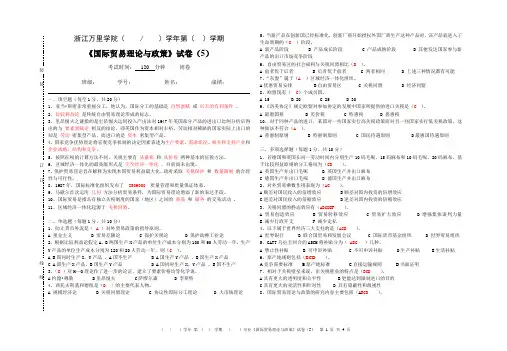
5、当新产品在创新国已经标准化,创新厂商开始授权外国厂商生产这种产品时,该产品就进入了Array生命周期的(C)阶段。
A 新产品阶段B 产品成长阶段C 产品成熟阶段D 其他发达国家参与新产品的出口市场竞争阶段6、自由贸易区的社会福利与关税同盟相比(D)。
A 前者优于后者B 后者优于前者C 两者相同D 上述三种情况都有可能7、“东盟”属于(A)区域经济一体化组织。
A优惠贸易安排 B自由贸易区 C 关税同盟 D 经济同盟8、欧盟现有(C)个成员国。
A 15B 20C 25D 309、《洛美协定》规定欧盟对参加协定的发展中国家所提供的进口关税是(C)。
A 最惠国税B 差价税C 特惠税D 普惠税10、对于同种产品的进口,某国对一些国家实行高关税政策而对另一些国家实行低关税政策,这种做法不符合(A )。
A 普惠制原则B 特惠制原则C 国民待遇原则 D最惠国待遇原则三、多项选择题(每题1分,共10分)1、若德国和英国在同一劳动时间内分别生产10码毛呢、15码麻布和10码毛呢、20码麻布,基于比较利益原则的分工格局为(CD )。
A 英国生产并出口毛呢B 英国生产并出口麻布C 德国生产并出口毛呢D 德国生产并出口麻布2、对外贸易乘数作用表现为(AC)。
A顺差对国民收入的倍增效应 B顺差对国内投资的倍增效应C逆差对国民收入的倍缩效应 D逆差对国内投资的倍缩效应3、关税同盟的静态效应有(ABCDEF )。
A 贸易创造效应 B贸易转移效应 C 贸易扩大效应 D 增强集体谈判力量E 减少行政开支F 减少走私4、以下属于世界经济三大支柱的是(ACD )。
A 世界银行B 联合国贸易和发展会议C 国际货币基金组织D 世界贸易组织5、GATT乌拉圭回合的ASCM将补贴分为(ABC)几种。
A 禁止性补贴B 可申诉补贴C 不可申诉补贴 D生产补贴 E生活补贴6、原产地规则包括(BCD )。
A竞争需要标准B原产地标准C直接运输规则D书面证明7、相对于关税壁垒来说,非关税壁垒的特点是(BCD)。
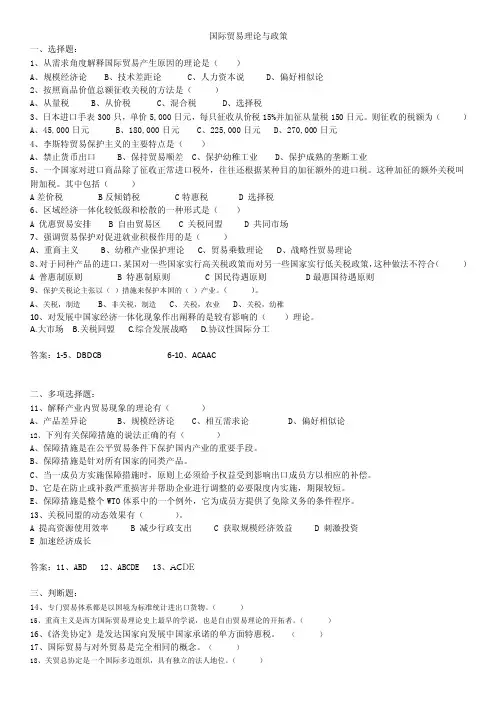
国际贸易理论与政策一、选择题:1、从需求角度解释国际贸易产生原因的理论是()A、规模经济论B、技术差距论C、人力资本说D、偏好相似论2、按照商品价值总额征收关税的方法是()A、从量税B、从价税C、混合税D、选择税3、日本进口手表300只,单价5,000日元,每只征收从价税15%并加征从量税150日元。
则征收的税额为()A、45,000日元B、180,000日元C、225,000日元D、270,000日元4、李斯特贸易保护主义的主要特点是()A、禁止货币出口B、保持贸易顺差C、保护幼稚工业D、保护成熟的垄断工业5、一个国家对进口商品除了征收正常进口税外,往往还根据某种目的加征额外的进口税。
这种加征的额外关税叫附加税。
其中包括()A差价税 B反倾销税 C特惠税 D 选择税6、区域经济一体化较低级和松散的一种形式是()A 优惠贸易安排B 自由贸易区C 关税同盟D 共同市场7、强调贸易保护对促进就业积极作用的是()A、重商主义B、幼稚产业保护理论C、贸易乘数理论D、战略性贸易理论8、对于同种产品的进口,某国对一些国家实行高关税政策而对另一些国家实行低关税政策,这种做法不符合()A 普惠制原则B 特惠制原则C 国民待遇原则 D最惠国待遇原则9、保护关税论主张以()措施来保护本国的()产业。
()。
A、关税,制造B、非关税,制造C、关税,农业D、关税,幼稚10、对发展中国家经济一体化现象作出阐释的是较有影响的()理论。
A.大市场B.关税同盟C.综合发展战略D.协议性国际分工答案:1-5、DBDCB 6-10、ACAAC二、多项选择题:11、解释产业内贸易现象的理论有()A、产品差异论B、规模经济论C、相互需求论D、偏好相似论12、下列有关保障措施的说法正确的有()A、保障措施是在公平贸易条件下保护国内产业的重要手段。
B、保障措施是针对所有国家的同类产品。
C、当一成员方实施保障措施时,原则上必须给予权益受到影响出口成员方以相应的补偿。
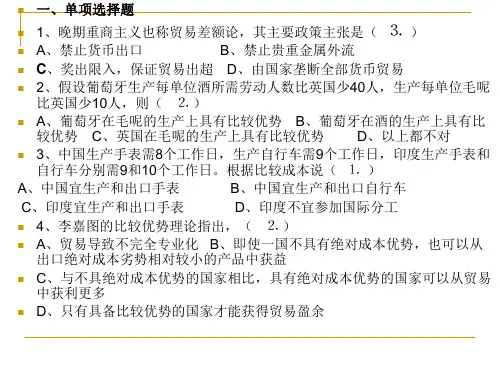
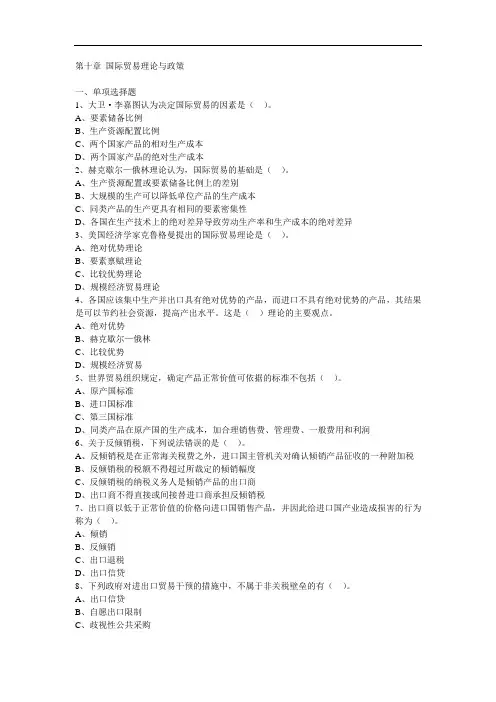
第十章国际贸易理论与政策一、单项选择题1、大卫·李嘉图认为决定国际贸易的因素是()。
A、要素储备比例B、生产资源配置比例C、两个国家产品的相对生产成本D、两个国家产品的绝对生产成本2、赫克歇尔—俄林理论认为,国际贸易的基础是()。
A、生产资源配置或要素储备比例上的差别B、大规模的生产可以降低单位产品的生产成本C、同类产品的生产更具有相同的要素密集性D、各国在生产技术上的绝对差异导致劳动生产率和生产成本的绝对差异3、美国经济学家克鲁格曼提出的国际贸易理论是()。
A、绝对优势理论B、要素禀赋理论C、比较优势理论D、规模经济贸易理论4、各国应该集中生产并出口具有绝对优势的产品,而进口不具有绝对优势的产品,其结果是可以节约社会资源,提高产出水平。
这是()理论的主要观点。
A、绝对优势B、赫克歇尔—俄林C、比较优势D、规模经济贸易5、世界贸易组织规定,确定产品正常价值可依据的标准不包括()。
A、原产国标准B、进口国标准C、第三国标准D、同类产品在原产国的生产成本,加合理销售费、管理费、一般费用和利润6、关于反倾销税,下列说法错误的是()。
A、反倾销税是在正常海关税费之外,进口国主管机关对确认倾销产品征收的一种附加税B、反倾销税的税额不得超过所裁定的倾销幅度C、反倾销税的纳税义务人是倾销产品的出口商D、出口商不得直接或间接替进口商承担反倾销税7、出口商以低于正常价值的价格向进口国销售产品,并因此给进口国产业造成损害的行为称为()。
A、倾销B、反倾销C、出口退税D、出口信贷8、下列政府对进出口贸易干预的措施中,不属于非关税壁垒的有()。
A、出口信贷B、自愿出口限制C、歧视性公共采购D、卫生检疫标准9、关税壁垒政策是通过()来实现的。
A、技术标准B、自愿出口限制C、征收高额关税D、进口配额制10、下列政府政策措施中,能对进口贸易产生限制作用的是()。
A、设定卫生检验标准B、直接补贴C、出口信贷D、限制倾销11、政府对本国的进出口贸易进行干预的各项措施中,以现金形式弥补出口企业国际市场价格和本国国内市场价格的差价的方式属于()。
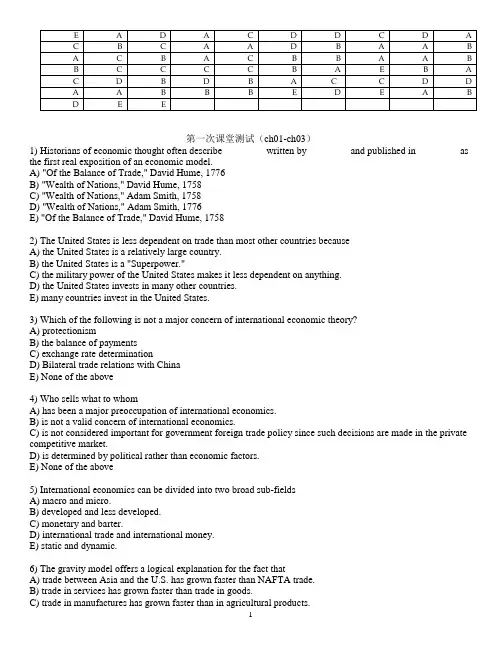
第一次课堂测试(ch01-ch03)1) Historians of economic thought often describe ________ written by ________ and published in ________ as the first real exposition of an economic model.A) "Of the Balance of Trade," David Hume, 1776B) "Wealth of Nations," David Hume, 1758C) "Wealth of Nations," Adam Smith, 1758D) "Wealth of Nations," Adam Smith, 1776E) "Of the Balance of Trade," David Hume, 17582) The United States is less dependent on trade than most other countries becauseA) the United States is a relatively large country.B) the United States is a "Superpower."C) the military power of the United States makes it less dependent on anything.D) the United States invests in many other countries.E) many countries invest in the United States.3) Which of the following is not a major concern of international economic theory?A) protectionismB) the balance of paymentsC) exchange rate determinationD) Bilateral trade relations with ChinaE) None of the above4) Who sells what to whomA) has been a major preoccupation of international economics.B) is not a valid concern of international economics.C) is not considered important for government foreign trade policy since such decisions are made in the private competitive market.D) is determined by political rather than economic factors.E) None of the above5) International economics can be divided into two broad sub-fieldsA) macro and micro.B) developed and less developed.C) monetary and barter.D) international trade and international money.E) static and dynamic.6) The gravity model offers a logical explanation for the fact thatA) trade between Asia and the U.S. has grown faster than NAFTA trade.B) trade in services has grown faster than trade in goods.C) trade in manufactures has grown faster than in agricultural products.D)Intra-European Union trade exceeds International Trade of the European Union.E) None of the above.7) Why does the gravity model work?A) Large economies became large because they were engaged in international trade.B) Large economies have relatively large incomes, and hence spend more on government promotion of trade and investment.C) Large economies have relatively larger areas which raises the probability that a productive activity will take place within the borders of that country.D) Large economies tend to have large incomes and tend to spend more on imports.E) None of the above.8) Since World War II, the relative importance of raw materials, including oil, in total world tradeA) remained constant.B) increased.C) decreased.D) fluctuated widely with no clear trendE) both A and D above.9) In the current Post-Industrial economy, international trade in services (including banking and financial services)A) dominates world trade.B) does not exist.C) is relatively small.D) is relatively stagnant.E) None of the above.10) In the pre-World War I period, the United Kingdom exported primarilyA) manufactured goods.B) services.C) primary products including agricultural.D) technology intensive products.E) None of the above.11) In the pre-World War I period, the United Kingdom imported primarilyA) manufactured goods.B) services.C) primary products including agricultural.D) technology intensive products.E) None of the above.12) In the present, most of the exports from China are inA) manufactured goods.B) services.C) primary products including agricultural.D) technology intensive products.E) None of the above.13) Which of the following does not explain the extent of trade between Ireland and the U.S.?A) Historical tiesB) Cultural Linguistic tiesC) Gravity modelD) Multinational CorporationsE) None of the above.14) Trade between two countries can benefit both countries ifA) each country exports that good in which it has a comparative advantage.B) each country enjoys superior terms of trade.C) each country has a more elastic demand for the imported goods.D) each country has a more elastic supply for the exported goods.E) Both C and D.15)Trade between two countries can benefit both countries ifA) each country exports that good in which it has a comparative advantage.B) each country enjoys superior terms of trade.C) each country has a more elastic demand for the imported goods.D) each country has a more elastic supply for the exported goods.E) Both C and D.16) In order to know whether a country has a comparative advantage in the production of one particularproduct we need information on at least ________ unit labor requirementsA) oneB) twoC) threeD) fourE) five17) A country engaging in trade according to the principles of comparative advantage gains from trade becauseitA) is producing exports indirectly more efficiently than it could alternatively.B) is producing imports indirectly more efficiently than it could domestically.C) is producing exports using fewer labor units.D) is producing imports indirectly using fewer labor units.E) None of the above.18) Given the information in the table above, if it is ascertained that Foreign uses prison-slave labor to produceits exports, then home shouldA) export cloth.B) export widgets.C) export both and import nothing.D) export and import nothing.E) All of the above.19) Given the information in the table above, if the Home economy suffered a meltdown, and the Unit LaborRequirements doubled to 30 for cloth and 60 for widgets then home shouldA) export cloth.B) export widgets.C) export both and import nothing.D) export and import nothing.E) All of the above.20) The earliest statement of the principle of comparative advantage is associated withA) David Hume.B) David Ricardo.C) Adam Smith.D) Eli Heckscher.E) Bertil Ohlin.21) The Gains from Trade associated with the principle of Comparative Advantage depends onA) the trade partners must differ in technology or tastes.B) there can be no more goods traded than the number of trade partners.C) there may be no more trade partners than goods traded.D) All of the above.E) None of the above.22) The Ricardian model demonstrates thatA) trade between two countries will benefit both countries.B) trade between two countries may benefit both regardless of which good each exports.C) trade between two countries may benefit both if each exports the product in which it has a comparativeadvantage.D) trade between two countries may benefit one but harm the other.E) None of the above.23) Given the information in the table aboveA) neither country has a comparative advantage.B) Home has a comparative advantage in cloth.C) Foreign has a comparative advantage in cloth.D) Home has a comparative advantage in widgets.E) Home has a comparative advantage in both products.24) Given the information in the table above, if wages were to double in Home, then Home shouldA) export cloth.B) export widgets.C) export both and import nothing.D) export and import nothing.E) All of the above.25) Given the information in the table aboveA) neither country has a comparative advantage.B) Home has a comparative advantage in cloth.C) Foreign has a comparative advantage in cloth.D) Foreign has a comparative advantage in widgets.E) Home has a comparative advantage in both products.26) Given the information in the table above, the opportunity cost of cloth in terms of widgets in Foreign is if it isascertained that Foreign uses prison-slave labor to produce its exports, then home shouldA) export cloth.B) export widgets.C) export both and import nothing.D) export and import nothing.E) All of the above.27) Given the information in the table above, if wages were to double in Home, then Home shouldA) export cloth.B) export widgets.C) export both and import nothing.D) export and import nothing.E) All of the above.28) Given the information in the table above, if the world equilibrium price of widgets were 4 Cloths, thenA) both countries could benefit from trade with each other.B) neither country could benefit from trade with each other.C) each country will want to export the good in which it enjoys comparative advantage.D) neither country will want to export the good in which it enjoys comparative advantage.E) both countries will want to specialize in cloth.29) Given the information in the table above, if the world equilibrium price of widgets were 40 cloths, thenA) both countries could benefit from trade with each other.B) neither country could benefit from trade with each other.C) each country will want to export the good in which it enjoys comparative advantage.D) neither country will want to export the good in which it enjoys comparative advantage.E) both countries will want to specialize in cloth.30) In a two product two country world, international trade can lead to increases inA) consumer welfare only if output of both products is increased.B) output of both products and consumer welfare in both countries.C) total production of both products but not consumer welfare in both countries.D) consumer welfare in both countries but not total production of both products.E) None of the above.31) As a result of trade, specialization in the Ricardian model tends to beA) complete with constant costs and with increasing costs.B) complete with constant costs and incomplete with increasing costs.C) incomplete with constant costs and complete with increasing costs.D) incomplete with constant costs and incomplete with increasing costs.E) None of the above.32) As a result of trade between two countries which are of completely different economic sizes, specialization inthe Ricardian 2X2 model tends to beA) incomplete in both countriesB) complete in both countriesC) complete in the small country but incomplete in the large countryD) complete in the large country but incomplete in the small countryE) None of the above.33) A nation engaging in trade according to the Ricardian model will find its consumption bundleA) inside its production possibilities frontier.B) on its production possibilities frontier.C) outside its production possibilities frontier.D) inside its trade-partner's production possibilities frontier.E) on its trade-partner's production possibilities frontier.34) In the Ricardian model, if a country's trade is restricted, this will cause all except which?A) limit specialization and the division of laborB) reduce the volume of trade and the gains from tradeC) cause nations to produce inside their production possibilities curvesD) may result in a country producing some of the product of its comparative disadvantageE) None of the above.35) If a very small country trades with a very large country according to the Ricardian model, thenA) the small country will suffer a decrease in economic welfare.B) the large country will suffer a decrease in economic welfare.C) the small country only will enjoy gains from trade.D) the large country will enjoy gains from trade.E) None of the above.36) If the world terms of trade for a country are somewhere between the domestic cost ratio of H and that of F,thenA) country H but not country F will gain from trade.B) country H and country F will both gain from trade.C) neither country H nor F will gain from trade.D) only the country whose government subsidizes its exports will gain.E) None of the above.37) If the world terms of trade equal those of country F, thenA) country H but not country F will gain from trade.B) country H and country F will both gain from trade.C) neither country H nor F will gain from trade.D) only the country whose government subsidizes its exports will gain.E) None of the above.38) If the world terms of trade equal those of country H, thenA) country H but not country F will gain from trade.B) country H and country F will both gain from trade.C) neither country H nor F will gain from trade.D) only the country whose government subsidizes its exports will gain.E) None of the above.39) According to Ricardo, a country will have a comparative advantage in the product in which itsA) labor productivity is relatively low.B) labor productivity is relatively high.C) labor mobility is relatively low.D) labor mobility is relatively high.E) None of the above.40) Assume that labor is the only factor of production and that wages in the United States equal $20 per hourwhile wages in Japan are $10 per hour. Production costs would be lower in the United States as compared to Japan ifA) U.S. labor productivity equaled 40 units per hour and Japan's 15 units per hour.B) U.S. productivity equaled 30 units per hour whereas Japan's was 20.C) U.S. labor productivity equaled 20 and Japan's 30.D) U.S. labor productivity equaled 15 and Japan's 25 units per hour.E) None of the above.41) If two countries engage in Free Trade following the principles of comparative advantage, thenA) neither relative prices nor relative marginal costs (marginal rates of transformation-MRTs) in onecountry will equal those in the other country.B) both relative prices and MRTs will become equal in both countries.C) relative prices but not MRTs will become equal in both countries.D) MRTs but not relative prices will become equal in both countries.E) None of the above.42) Let us define the real wage as the purchasing power of one hour of labor. In the Ricardian 2X2 model, if twocountries under autarky engage in trade thenA) the real wage will not be affected since this is a financial variable.B) the real wage will increase only if a country attains full specialization.C) the real wage will increase in one country only if it decreases in the other.D) the real wage will rise in both countries.E) None of the above.43) In a two country and two product Ricardian model, a small country is likely to benefit more than the largecountry becauseA) the large country will wield greater political power, and hence will not yield to market signals.B) the small country is less likely to trade at price equal or close to its autarkic (domestic) relative prices.C) the small country is more likely to fully specialize.D) the small country is less likely to fully specialize.E) None of the above.44) In the Ricardian model, comparative advantage is not likely be due toA) scale economies.B) home product taste bias.C) greater capital availability per worker.D) All of the above.E) None of the above.45) If a production possibilities frontier is bowed out (concave to the origin), then production occurs underconditions ofA) constant opportunity costs.B) increasing opportunity costs.C) decreasing opportunity costs.D) infinite opportunity costs.E) None of the above.46) If the production possibilities frontier of one the trade partners ("Country A") is bowed out (concave to theorigin), then increased specialization in production by that country willA) increase the economic welfare of both countries.B) increase the economic welfare of only Country A.C) decrease the economic welfare of Country A.D) decrease the economic welfare of Country B.E) None of the above.47) If two countries have identical production possibility frontiers, then trade between them is not likely ifA) their supply curves are identical.B) their cost functions are identical.C) their demand conditions are identical.D) their incomes are identical.E) None of the above.48) If two countries have identical production possibility frontiers, then trade between them is not likely ifA) their supply curves are identical.B) their cost functions are identical.C) their demand functions differ.D) their incomes are identical.E) None of the above.49) If one country's wage level is very high relative to the other's (the relative wage exceeding the relativeproductivity ratios), then if they both use the same currencyA) neither country has a comparative advantage.B) only the low wage country has a comparative advantage.C) only the high wage country has a comparative advantage.D) consumers will still find trade worth while from their perspective.E) None of the above.50) If one country's wage level is very high relative to the other's (the relative wage exceeding the relativeproductivity ratios), thenA) it is not possible that producers in each will find export markets profitable.B) it is not possible that consumers in both countries will enhance their respective welfares throughimports.C) it is not possible that both countries will find gains from trade.D) it is possible that both will enjoy the conventional gains from trade.E) None of the above.51) If one country's wage level is very high relative to the other's (the relative wage exceeding the relativeproductivity ratios) then it is probable thatA) free trade will improve both countries' welfare.B) free trade will result in no trade taking place.C) free trade will result in each country exporting the good in which it enjoys comparative advantage.D) free trade will result in each country exporting the good in which it suffers the greatest comparativedisadvantage.E) None of the above.52) In a two-country, two-product world, the statement "Germany enjoys a comparative advantage over Francein autos relative to ships" is equivalent toA) France having a comparative advantage over Germany in ships.B) France having a comparative disadvantage compared to Germany in autos and ships.C) Germany having a comparative advantage over France in autos and ships.D) France having no comparative advantage over Germany.E) None of the above.53) If the United States' production possibility frontier was flatter to the widget axis, whereas Germany's wasflatter to the butter axis, we know thatA) the United States has no comparative advantageB) Germany has a comparative advantage in butter.C) the U.S. has a comparative advantage in butter.D) Not enough information is given.E) None of the above.54) Suppose the United States' production possibility frontier was flatter to the widget axis, whereas Germany'swas flatter to the butter axis. We now learn that the German mark sharply depreciates against the U.S. dollar.We now know thatA) the United States has no comparative advantageB) Germany has a comparative advantage in butter.C) the United States has a comparative advantage in butter.D) Not enough information is given.E) None of the above.55) Suppose the United states production possibility frontier was flatter to the widget axis, whereas Germany'swas flatter to the butter axis. We now learn that the German wage doubles, but U.S. wages do not change at all. We now know thatA) the United States has no comparative advantage.B) Germany has a comparative advantage in butter.C) the United States has a comparative advantage in butter.D) Not enough information is given.E) None of the above.56) Which of the following statements is true?A) Free trade is beneficial only if your country is strong enough to stand up to foreign competition.B) Free trade is beneficial only if your competitor does not pay unreasonably low wages.C) Free trade is beneficial only if both countries have access to the same technology.D) All of the above.E) None of the above.57) Mahatma Ghandi exhorted his followers in India to promote economic welfare by decreasing imports. ThisapproachA) makes no sense.B) makes no economic sense.C) is consistent with the the Ricardian model of comparative advantage.D) is not consistent with the Ricardian model of comparative advantage.E) None of the above.58) The Country of Rhozundia is blessed with rich copper deposits. The cost of Copper produced (relative to thecost of Widgets produced) is therefore very low. From this information we know thatA) Rhozundia has a comparative advantage in CopperB) Rhozundia should export Copper and import WidgetsC) Rhozundia should export Widgets and export CopperD) Both A and B are true.E) None of the above.59) We know that in antiquity, China exported silk because no-one in any other country knew how to producethis product. From this information we learn thatA) China enjoyed a comparative advantage in silk.B) China enjoyed an absolute advantage, but not a comparative advantage in silk.C) no comparative advantage exists because technology was not diffused.D) China should have exported silk even though it had no comparative advantage.E) None of the above.60) The pauper labor theory, and the exploitation argumentA) are theoretical weaknesses that limit the applicability of the Ricardian concept of comparativeadvantage.B) are theoretically irrelevant to the Ricardian model, and do not limit its logical cogency.C) are not relevant because the Ricardian model is based on the labor theory of value.D) are not relevant because the Ricardian model allows for different technologies in different countries.E) None of the above.61) If labor productivities were exactly proportional to wage levels internationally, this wouldA) not negate the logical basis for trade in the Ricardian model.B) render the Ricardian model theoretically correct but practically useless.C) negate the logical basis for trade in the Ricardian model.D) negate the applicability of the Ricardian model if the number of products were greater than the numberof trading partners.E) None of the above.62) The multi-good (2-country) model differs from the two country, two product model, in that in the former,A) the relative wage ratio will determine the pattern of trade ( which good is exported by which country.B) one cannot determine which country will export which product given only labor productivity data.C) full specialization is less likely to hold in equilibrium.D) All of the above.E) None of the above.63) If transportation costs are especially high for Widgets in a Ricardian 2X2 model in which Country A enjoys acomparative advantage, thenA) Country B must also enjoy a comparative advantage in Widgets.B) Country B may end up exporting Widgets.C) Country A may switch to having a comparative advantage in the other good.D) All of the above.E) None of the above.。
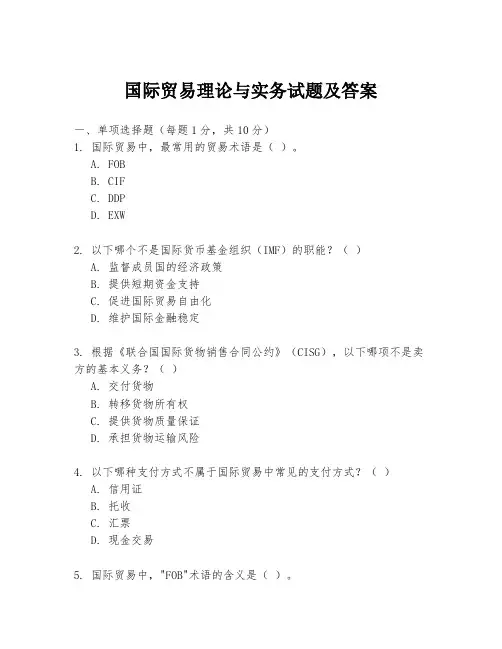
国际贸易理论与实务试题及答案一、单项选择题(每题1分,共10分)1. 国际贸易中,最常用的贸易术语是()。
A. FOBB. CIFC. DDPD. EXW2. 以下哪个不是国际货币基金组织(IMF)的职能?()A. 监督成员国的经济政策B. 提供短期资金支持C. 促进国际贸易自由化D. 维护国际金融稳定3. 根据《联合国国际货物销售合同公约》(CISG),以下哪项不是卖方的基本义务?()A. 交付货物B. 转移货物所有权C. 提供货物质量保证D. 承担货物运输风险4. 以下哪种支付方式不属于国际贸易中常见的支付方式?()A. 信用证B. 托收C. 汇票D. 现金交易5. 国际贸易中,"FOB"术语的含义是()。
B. 货物在目的港交货,卖方承担所有风险和费用C. 货物在装运港交货,卖方承担所有风险和费用D. 货物在目的港交货,买方承担所有风险和费用6. 以下哪个因素不是影响国际商品价格的因素?()A. 供求关系B. 货币汇率C. 政治因素D. 产品重量7. 国际贸易中,"CIF"术语的含义是()。
A. 成本加保险费加运费B. 成本加运费C. 货物交货价格D. 离岸价格8. 以下哪个不是国际贸易中的贸易壁垒?()A. 关税壁垒B. 配额限制C. 技术标准D. 贸易补贴9. 根据国际商会(ICC)的规定,以下哪项不是信用证的主要内容?()A. 信用证的开证日期B. 信用证的有效期C. 信用证的金额D. 卖方的银行账户信息10. 国际贸易中,"DDP"术语的含义是()。
B. 货物在装运港交货,买方承担所有风险和费用C. 货物在目的港交货,买方承担所有风险和费用D. 货物在装运港交货,卖方承担所有风险和费用答案:1. B2. C3. D4. D5. A6. D7. A8. D9. D10. A二、简答题(每题5分,共20分)1. 简述国际贸易中常见的贸易术语有哪些,并解释FOB和CIF术语的含义。
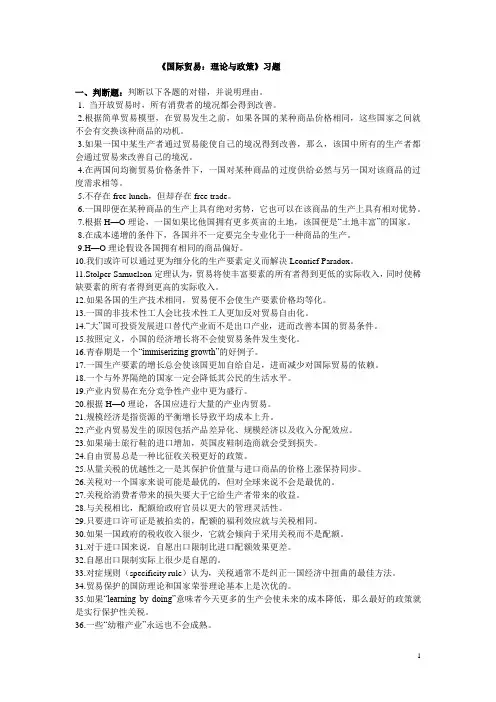
《国际贸易:理论与政策》习题一、判断题:判断以下各题的对错,并说明理由。
·1. 当开放贸易时,所有消费者的境况都会得到改善。
·2.根据简单贸易模型,在贸易发生之前,如果各国的某种商品价格相同,这些国家之间就不会有交换该种商品的动机。
·3.如果一国中某生产者通过贸易能使自己的境况得到改善,那么,该国中所有的生产者都会通过贸易来改善自己的境况。
·4.在两国间均衡贸易价格条件下,一国对某种商品的过度供给必然与另一国对该商品的过度需求相等。
·5.不存在free lunch,但却存在free trade。
·6.一国即便在某种商品的生产上具有绝对劣势,它也可以在该商品的生产上具有相对优势。
·7.根据H—O理论,一国如果比他国拥有更多英亩的土地,该国便是“土地丰富”的国家。
·8.在成本递增的条件下,各国并不一定要完全专业化于一种商品的生产。
·9.H—O理论假设各国拥有相同的商品偏好。
10.我们或许可以通过更为细分化的生产要素定义而解决Leontief Paradox。
11.Stolper-Samuelson定理认为,贸易将使丰富要素的所有者得到更低的实际收入,同时使稀缺要素的所有者得到更高的实际收入。
12.如果各国的生产技术相同,贸易便不会使生产要素价格均等化。
13.一国的非技术性工人会比技术性工人更加反对贸易自由化。
14.“大”国可投资发展进口替代产业而不是出口产业,进而改善本国的贸易条件。
15.按照定义,小国的经济增长将不会使贸易条件发生变化。
16.青春期是一个“immiserizing growth”的好例子。
17.一国生产要素的增长总会使该国更加自给自足,进而减少对国际贸易的依赖。
18.一个与外界隔绝的国家一定会降低其公民的生活水平。
19.产业内贸易在充分竞争性产业中更为盛行。
20.根据H—0理论,各国应进行大量的产业内贸易。
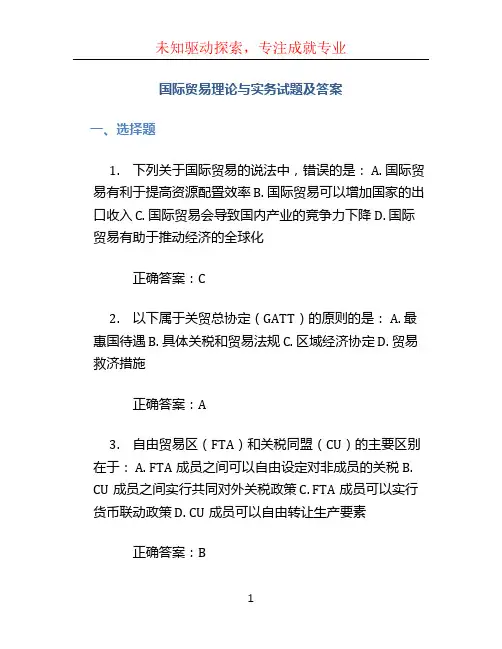
国际贸易理论与实务试题及答案一、选择题1.下列关于国际贸易的说法中,错误的是: A. 国际贸易有利于提高资源配置效率 B. 国际贸易可以增加国家的出口收入 C. 国际贸易会导致国内产业的竞争力下降 D. 国际贸易有助于推动经济的全球化正确答案:C2.以下属于关贸总协定(GATT)的原则的是: A. 最惠国待遇 B. 具体关税和贸易法规 C. 区域经济协定 D. 贸易救济措施正确答案:A3.自由贸易区(FTA)和关税同盟(CU)的主要区别在于: A. FTA成员之间可以自由设定对非成员的关税 B. CU成员之间实行共同对外关税政策 C. FTA成员可以实行货币联动政策 D. CU成员可以自由转让生产要素正确答案:B二、问答题1.解释国际贸易的绝对优势理论,并结合实际案例进行说明。
国际贸易的绝对优势理论由亚当·斯密提出,认为一个国家在生产某种商品方面的成本相对较低时,就具有了该商品的绝对优势,应该专门从事该商品的生产和出口。
这样,不同国家可以通过国际贸易,在各自擅长的领域互通有无,提高资源配置效率和国际贸易的总收益。
例如,中国和巴西是两个农产品生产大国,中国的成本较低,而巴西具有不同的气候和土壤条件,使得巴西的某些农产品生产成本较低。
根据绝对优势理论,中国可以专门从事生产自己成本低的农产品,而巴西可以专门从事生产自己成本低的农产品,两国之间进行农产品贸易,使得双方都能够获得更高效率和更大的收益。
2.什么是最惠国待遇?它在国际贸易中的作用是什么?最惠国待遇是指一个国家将对一个贸易伙伴国家给予的最低关税率、最低限度的贸易限制等优惠待遇,扩大到对其他所有世界贸易组织成员国(WTO)的贸易伙伴同样适用的原则。
即使某个国家对自己的主要贸易伙伴国家给予更多的优惠待遇,但它对其他成员国也必须遵守最惠国待遇原则,给予相同的优惠待遇。
最惠国待遇在国际贸易中的作用是消除了国家之间的歧视性,避免了以国家为基础的贸易配额和额外关税的设置,保护了全球贸易的公平性和自由性。
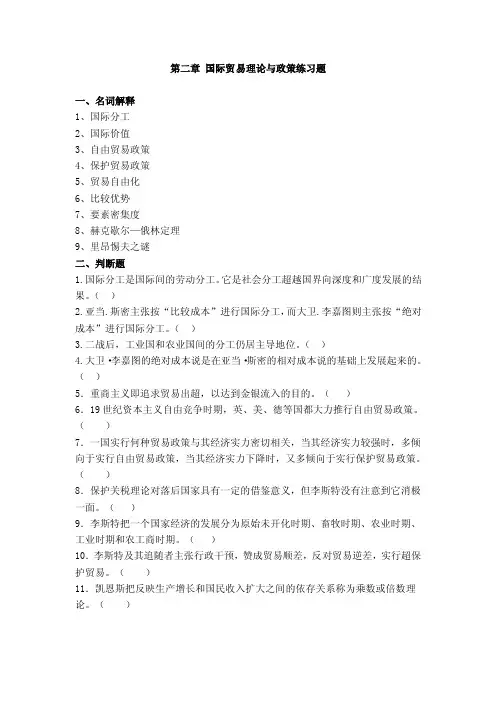
第二章国际贸易理论与政策练习题一、名词解释1、国际分工2、国际价值3、自由贸易政策4、保护贸易政策5、贸易自由化6、比较优势7、要素密集度8、赫克歇尔—俄林定理9、里昂惕夫之谜二、判断题1.国际分工是国际间的劳动分工。
它是社会分工超越国界向深度和广度发展的结果。
()2.亚当.斯密主张按“比较成本”进行国际分工,而大卫.李嘉图则主张按“绝对成本”进行国际分工。
()3.二战后,工业国和农业国间的分工仍居主导地位。
()4.大卫·李嘉图的绝对成本说是在亚当·斯密的相对成本说的基础上发展起来的。
()5.重商主义即追求贸易出超,以达到金银流入的目的。
()6.19世纪资本主义自由竞争时期,英、美、德等国都大力推行自由贸易政策。
()7.一国实行何种贸易政策与其经济实力密切相关,当其经济实力较强时,多倾向于实行自由贸易政策,当其经济实力下降时,又多倾向于实行保护贸易政策。
()8.保护关税理论对落后国家具有一定的借鉴意义,但李斯特没有注意到它消极一面。
()9.李斯特把一个国家经济的发展分为原始未开化时期、畜牧时期、农业时期、工业时期和农工商时期。
()10.李斯特及其追随者主张行政干预,赞成贸易顺差,反对贸易逆差,实行超保护贸易。
()11.凯恩斯把反映生产增长和国民收入扩大之间的依存关系称为乘数或倍数理论。
()12.托马斯·孟认为发展对外贸易是增加财富的手段,但必须保证贸易顺差。
()三、填空题1. 自由贸易理论、保护幼稚工业理论、超保护贸易理论、当代自由贸易理论的代表人物分别是:、、、。
2. 统一的世界市场的基本特征是的,以及。
3. 重商主义在理论上只考察了流通领域,而没有进入到生产领域;在政策上主张国家干预经济和。
4. 一国的对外贸易政策大体上包括:,,。
5. 帝国主义的侵略性保护政策具有极大的和。
6._________就是以国内生产的工业品代替进口产品的政策。
7.__________指用工业制成品和半制成品的出口代替初级产品出口的政策。
第一章国际贸易概述一、单选题1、国际分工与国际贸易理论的创始者是()A 、李嘉图B、赫克歇尔C、里昂惕夫D、亚当.斯密2、从世界范围看,世界各国之间货物与服务交换的活动称为()A、国际贸易B、对外贸易C、多国贸易D、双边贸易3、联合国编制和发表的世界各国对外贸易额的资料以()A、欧元表示B、美元表示C、本国货币表示D、日元表示4、各国在进行货物贸易统计时对于出口额的资料以()A、FOB计价 B 、CIF计价C、CFR计价D、EXW计价5、某年世界出口贸易额为1.6万亿美元,进口贸易额为1.7万亿美元,该年国际贸易额为()A、3.3万亿美元B、1.6万亿美元C、1.7万亿美元D、1.5万亿美元6、真正能够反映一个国家对外贸易实际规模的指标是()A、对外贸易量B、对外贸易额 C 、对外贸易依存度D、对外贸易值7、以货物通过国境为标准统计进出口的是()A、无形商品贸易B、过境贸易C、总贸易体系D、国境贸易8、在专门贸易体系中,作为进出口统计标准的是()A、海关结关 B 、货物通过国境C、交纳税费D、订立合同9、我国出口一批货物给香港某公司,该香港公司又将这批货物转卖给美国某公司,这个贸易现象对香港而言称为()A、间接进口B、间接出口C、转口贸易D、易货贸易10、当一国的出口额大于其进口额时,称为()A、国际收支逆差B、国际收支顺差C、对外贸易逆差D、对外贸易顺差11、2003年,美国的进出口额为2万亿美元,GDP为10万亿美元,因此,美国当年的对外贸易系数约为()A、2%B、4%C、10% D 、20%二、多选题1、贸易国家进行对外货物贸易统计所采用的统计制度包括()A、直接贸易体系B、总贸易体系C、专门贸易体系D、货物贸易体系E、服务贸易体系2 、下列产品属于初级产品的有()A、矿物燃料B、动植物油脂C、饮料及烟类D、机械及运输设备E、塑料制品3、按照世界贸易组织的分类,服务行业包括的部门有()A、通讯B、家电制造C、银行D、建筑E、交通第二章国际贸易的利益一、单选题1、国际分工产生和发展的基础是()。
国贸一、单选题(每题1分,共10分)1、世界出口总额与世界进口总额之间的关系是(c)A、前者等于后者B、前者大于后者C、前者小于后者D、不能确定2、按“两优取其重,两劣取其轻”的原则进行分工的思想是由( B )创立。
A、亚当·斯密B、大卫·李嘉图C、凯恩斯D、托马斯·孟3、里昂惕夫之谜论说明了( C)与()存在的矛盾。
A、绝对优势论,比较优势论B、比较优势论,要素禀赋论C、实践的验证结果,要素禀赋论理论结论D、实践的验证结果,比较优势论理论结论4、从需求角度解释国际贸易产生原因的理论是( D)A、规模经济论B、技术差距论C、人力资本说D、偏好相似论5、在投资驱动阶段,竞争优势的获得主要来源是(C)A、自然资源要素的优势B、劳动力资源的优势C、资本优势D、技术优势6、世界贸易组织于(C)正式建立。
A、1993.12.15B、1994.4.15C、1995.1.1D、1996.1.17、经济一体化较低级和松散的一种形式是( A )A、优惠贸易安排B、自由贸易区C、关税同盟D、共同市场8.晚期重商主义认为增加一国财富的手段就是发展对外贸易但必须遵循的原则是卖给外国人的商品总值应( B)购买他们的商品总值,从而通过每年的贸易顺差来增加货币流入量。
A、小于B、大于C、等于D、不等于9、按照商品价值总额征收关税的方法是(B)A、从量税B、从价税C、混合税D、选择税10、对超过限额的商品禁止进口,称为:( D)A、协议配额B、关税配额C、自主配额D、绝对配额11、国际贸易额是指(D )A、一国进出口额之和B、各国进出口额之和C、各国进口额之和D、各国出口额之和12、一国拥有的资本要素充裕,故应专门生产资本密集型产品对外进行交换。
这种说法来自(D)A、李嘉图的比较利益论B、李斯特的保护幼稚工业论C、亚当·斯密的绝对利益论D、赫-俄的要素禀赋论13、技术差距论认为,贸易的可能性来自于( B )与()之间构成的时间差。
导论主观题及案例分析答案主观题答案1.从第一次世界大战爆发到第二次世界大战结束的这段时间2.国际贸易理论与政策是研究在资源约束条件下,国际贸易的产生及发展,国际贸易的成因、结构、数量及其利益分配,国际贸易体制政策等问题,以揭示其特点与运动规律的一门学问。
3. 分为六个阶段(1)国际贸易是于奴隶社会和封建社会时期产生的。
(2)真正意义上具有世界性质的国际贸易是于资本主义生产方式下准备时期发展起来的。
16世纪-18世纪,西欧各国资本主义生产方式的准备时期,世界市场初步形成,扩大了世界贸易的规模。
(3)18世纪后期到19世纪中叶,资本主义的自由竞争时期,真正的国际分工开始形成,交通和通讯联络的便利极大推动了国际贸易的发展。
(4)19世纪末20世纪初,资本主义国家进入垄断时期。
国际贸易仍在扩大,但是增长速度呈下降趋势。
这一时期,国际贸易中明显形成了大型垄断组织瓜分世界的局面。
少数富有的资本主义国家开始向殖民地国家输出资本。
(5)第二次世界大战以后,尤其是20世纪80年代以来国际贸易发展迅速,商品结构也发生了重大的变化,新商品涌现。
发达国际继续在国际贸易中占统治地位,但发展中国家在国际贸易中的地位有所加强。
(6)进入21世纪,以知识、资金、技术为生产要素基础的国际分工促进了新的国际贸易方式和交易手段。
当代的国际贸易主要特点是:贸易投资一体化、跨国公司对全球经济的主导作用日益加强等等。
4.学习国际贸易理论与政策要有一些必要的分析和理解问题的工具。
常用的工具:(1)用几何图形阐明国际贸易的基本理论、政策及其影响,用数学公式或函数式说明国际经济与贸易中各种经济变量之间的关系。
(2)要将理论与实际密切结合起来。
对复杂的理论和政策问题的理解是在联系实际中解决的。
(3)注重历史与逻辑相统一的研究方法。
逻辑的分析应以历史的考察为基础,历史的考察应以逻辑的分析为依据。
(4)把国际贸易问题置于一国(地区)政治、经济、军事、外交相结合的系统平台上进行考察。
国际贸易理论与政策计算题假设有两个国家A和B,分别生产两种商品X和Y。
他们的劳动力资源有限,因此必须在两种商品之间做出选择。
以下是两个国家生产商品X 和Y所需劳动时间的表格:商品X的生产所需劳动时间,商品Y的生产所需劳动时--------------,-----------------------,-----------------------国家A,6,4--------------,-----------------------,-----------------------国家B,3,51.分别计算国家A和国家B的机会成本。
机会成本是指生产其中一种商品时放弃生产另一种商品所付出的代价。
国家A生产X的机会成本:4/6=0.67Y国家A生产Y的机会成本:6/4=1.5X国家B生产X的机会成本:5/3=1.67Y国家B生产Y的机会成本:3/5=0.6X比较优势是指一个国家在生产其中一种商品上的机会成本较低,相对于其他商品。
根据上述机会成本计算,可以得出:3. 计算 trade gains(贸易收益)。
假设国家A和国家B决定进行贸易,互相交换他们的生产。
具体地,国家A专注于生产商品X,国家B专注于生产商品Y,并且他们进行特定比例的交换。
比如,国家A生产100个X,国家B生产100个Y,并且他们以1:1的比例交换。
这意味着国家A将给予国家B100个X,并且得到国家B给予的100个Y。
根据上述情况,我们可以计算出贸易前后的产出和消费情况。
-贸易前:国家A生产100个X的机会成本是0.67Y*100=67Y;国家B 生产100个Y的机会成本是0.6X*100=60X。
所以,贸易前国家A的总机会成本是67Y+0X=67Y,国家B的总机会成本是0Y+60X=60X。
-贸易后:国家A生产100个X的机会成本仍然是67Y,因为他们专注于生产X;国家B生产100个Y的机会成本仍然是60X,因为他们专注于生产Y。
但是,国家A得到了100个Y,国家B得到了100个X,使得两国的总机会成本变得更低。
国际贸易政策考试试题一、选择题(每题 2 分,共 20 分)1、以下哪项不是国际贸易政策的主要类型?()A 自由贸易政策B 保护贸易政策C 公平贸易政策D 管理贸易政策2、进口配额制属于()。
A 关税壁垒B 非关税壁垒C 出口鼓励措施D 进口鼓励措施3、一国货币贬值对其进出口贸易的影响是()。
A 出口增加,进口减少B 出口减少,进口增加C 出口和进口都增加D 出口和进口都减少4、以下哪项不是出口补贴的方式?()A 直接补贴B 间接补贴C 税收优惠D 进口配额5、技术性贸易壁垒主要包括()。
A 技术标准B 卫生检疫标准C 包装和标签规定D 以上都是6、最惠国待遇原则的实质是()。
A 平等对待所有贸易伙伴B 给予某些贸易伙伴优惠待遇C 歧视某些贸易伙伴D 对不同贸易伙伴实行差别待遇7、反倾销税的税额不得超过()。
A 倾销幅度B 正常价值C 出口价格D 国内价格8、区域经济一体化的最低层次是()。
A 自由贸易区B 关税同盟C 共同市场D 优惠贸易安排9、世界贸易组织的最高决策机构是()。
A 部长级会议B 总理事会C 理事会D 秘书处10、以下哪种贸易政策理论主张政府应积极干预对外贸易?()A 重商主义B 绝对优势理论C 比较优势理论D 要素禀赋理论二、判断题(每题 2 分,共 20 分)1、国际贸易政策的目的是保护本国产业和市场。
()2、自由贸易政策会导致本国产业受到冲击,因此不可取。
()3、关税是一种间接税。
()4、绿色贸易壁垒是一种合理的贸易保护手段。
()5、世界贸易组织允许成员国采取报复性措施。
()6、战略性贸易政策只适用于发达国家。
()7、进口替代战略有利于促进本国产业的升级。
()8、出口导向战略容易导致贸易失衡。
()9、普惠制是发达国家给予发展中国家的单方面优惠关税待遇。
()10、区域经济一体化程度越高,对成员国的经济发展越有利。
()三、简答题(每题 10 分,共 30 分)1、简述关税的作用。
国际贸易理论测试题(含答案)一、单选题(共40题,每题1分,共40分)1、目前世界上最高形式的区域经济一体化组织是()。
A、欧盟B、东盟C、亚太经合组织D、北美自由贸易区正确答案:A2、《联合国国际货物销售合同》规定的卖方的基本义务是()。
A、提供运输B、提交官方批准文件C、提交合格的货物和单据D、风险界限问题正确答案:C3、当一国的出口额大于其进口额时,称为()。
A、国际收支逆差B、对外贸易顺差C、对外贸易逆差D、国际收支顺差正确答案:B4、信用证项下的汇票的付款人是()。
A、出口人B、开证银行C、开证申请人D、议付银行正确答案:B5、绝对优势就是一国生产同种产品的劳动生产率绝对()另一国。
A、等于B、高于C、低于D、不确定正确答案:B6、根据INCOTERMS2010的解释,以CIF汉堡成交卖方对货物所承担的风险界限(风险责任)是()。
A、货物在装运港装上船以前B、货物在装运港卸下卖方车辆以前C、货物在目的港卸货以前D、货物在目的港装上买方车辆以前正确答案:A7、不可抗力条款是一项()。
A、维护卖方权益的条款B、维护买方权益的条款C、无法免责的条款D、免责条款正确答案:D8、某外面公司出口茶叶5公吨,在海运途中遭受暴风雨,海水涌入仓内,致使一部分茶叶发霉变质,这种损失属于()。
A、实际全损B、单独海损C、推定全损D、共同海损正确答案:B9、仲裁协议是仲裁机构受理争议案件的必要依据。
仲裁协议()达成。
A、只能在争议发生之后B、必须在争议发生的过程中C、既可以在争议发生之前,也可以在争议发生之后D、必须在争议发生之前正确答案:C10、()是指投保人与保险公司之间实际投保和承保的金额。
A、赔款额B、保险费C、产品成交额D、保险金额正确答案:D11、《2010年国际贸易术语解释通则》中,卖方承担义务最大的术语是()。
A、CIFB、CIPC、DDPD、DAT正确答案:C12、()可以采取“以毛作净”的方式计算。
厦门大学网络2008级国际贸易试题(A)一、名词解释:1、对外贸易依存度答:对外贸易依存度又称对外贸易系数,是指一国的对外贸易额占其国民生产总值(GNP)或国内生产总值(GDP)的比重。
2、关税同盟答:关税同盟是两个或两个以上国家相互完全取消关税和非关税壁垒,并对其他国家实行统一的关税制度而缔结的同盟。
3、普惠税答:是指发达国家承诺对从发展中国家或地区输入的制成品和半制成品,给予优惠的关税待遇。
4、国民待遇条款答:国民待遇的基本涵义是缔约一方保证缔约另一方的产品、服务或服务提供者及知识产权所有者和持有者所提供的待遇,不低于本国同类产品、服务或服务提供者及知识产权所有者和持有者所享有的待遇。
5、进口押金制答:该制度规定,进口商在进口商品时,必须按规定的时间和指定的银行无息存储相当于进口金额一定比例的存款,方准进口。
二、单项选择:1、经济一体化较低级和松散的一种形式是( D )A、经济同盟B、自由贸易区C、关税同盟D、优惠贸易安排2、进口配额制主要包括两种:绝对配额和( A )。
A、关税配额B、全球配额C、国别配额D、协议配额3、下列哪一个因素是国际分工产生和发展的决定性因素( C )。
A、国际生产关系B、自然条件C、社会生产力D、上层建筑4、能够比较确切地反映一国对外贸易实际规模,便于各个时期进行比较的是( B )指标。
A、贸易顺差B、对外贸易量C、对外贸易额D、对外贸易商品结构5、英国海默关于跨国公司的理论称之为( A )A、垄断优势论B、内部化理论C、国际生产折衷理论D、要素比例说三、多项选择:1、、各国制定对外贸易政策的目的在于(A、B、C、D、E )A、保护本国市场B扩大本国产品的出口市场C、促进本国产业结构的改善D、积累资本或资金E、维护本国对外的政治关系2、普惠制的主要原则是(A、C、E )A、普遍的B、互惠的C、非互惠的D、歧视的E、非歧视的3、关税与其他税收一样具有(B、C、E )。
A、自愿性B、强制性C、无偿性D、有偿性E、预定性4、外汇倾销可以(A、D )。
A、促进出口B、限制出口C、促进进口D、限制进口E、促进进出口5、按照征收关税的目的分,关税可以分为:(A、D )A、保护关税B、反补贴税C、反倾销税 D 财政关税四、简答题:1、简述二次世界大战后国际分工的主要特征。
答:第一,在国际分工格局中,工业国与工业国之间的分工居于主导地位。
第二,各国间工业部门内部分工日益深化。
部门内分工的形成主要有:(1)不同型号规格产品的专业化分工。
(2)零配件和部件生产的专业化分工。
(3)工艺过程的专业化分工。
第三,发达国家与发展中国家间的分工在发展,而工业国与农业国、矿业国的分工在削弱。
第四,经济贸易集团内部分工趋势加强。
第五,国际分工从垂直型的分工向水平型分工发展。
第六,参与国际分工国家的类型和经济制度有显著变化。
第七、国际分工从有形商品生产和贸易领域向服务业领域扩展,并出现了相互结合、相互渗透的趋势。
2、简述二次战后国际服务贸易迅速发展的原因。
答(一)、世界产业结构升级(二)、科技革命的驱动(三)、跨国公司促进了国际服务贸易的发展(四)、多样化的国际服务合作方式加速了国际服务贸易的发展(五)、各国政府的支持是国际服务贸易迅速发展的催化剂3、简述进口替代对发展中国家经济发展的利弊影响。
答:(1)、提供了一个有保护的、有利可图的国内市场,使一些发展中国家的工业特别是制造业得到迅速发展。
(2)、改变了一些发展中国家单一形的经济结构。
(3)、使一些发展中国家经济的独立性获得较大加强。
(4)、改善了一些发展中国家在国际贸易中的不平等地位,在一定程度上改善了这些国家的贸易条件。
2、进口替代政策的消极影响(1)、加剧而不是缓和了国际收支失衡。
(2)、往往导致国内经济发展的高成本和低效率。
(3)、难于获得规模经济效益。
(4)、资源配置不合理,使已存在的二元经济结构进一步强化。
4、简述跨国公司内部贸易对国际贸易的影响。
答:(一)、跨国公司内部贸易在世界贸易中占据重要地位。
(二)、促使国际贸易迅速增长。
(三)、对国际贸易商品结构产生影响。
(四)、在一定程度上,改变了国际贸易商品的流向。
(五)、在一定程度上改变了国际贸易的比较利益基础。
(六)、转移价格的订价机制改变了价格作为市场信号的贸易秩序。
(七)使国际贸易关系复杂化。
(八)使世界市场结构发生变化,竞争趋于激烈。
5、什么叫从价税?征收从价税有哪些优点?答:从价税是按照进口商品的价格为标准计征的关税,其税率表现为货物价格的百分率。
征收从价税的优点是:(1)、征收手续比较简单,对于同种商品,可不必因其品质的不同,再详加分类;(2)、税率明确,便于比较各国税率;(3)、税负公平,从价税额随商品价格与品质的高低而增减,比较符合税收公平原则;(4)、物价上涨而进口数量不变时,财政收入增加。
6、何谓产业内贸易?它有哪些特点?产业内贸易是生产要素禀赋相似、产业结构相似和消费结构相似的工业国之间的贸易。
一般来说,产业内贸易具有以下特点:1、贸易的对象是同类产品,流向具有双向性。
2、产业内贸易的品种复杂繁多,可以是劳动密集型产品,也可以是资本技术密集型产品。
3、产业内贸易的产品一般在消费上具有替代性,产品生产所需的要素投入具有类似性。
1、贸易的对象是同类产品,流向具有双向性。
2、产业内贸易的品种复杂繁多,可以是劳动密集型产品,也可以是资本技术密集型产品。
3、产业内贸易的产品一般在消费上具有替代性,产品生产所需的要素投入具有类似性。
五、论述题:1、阐述出口贸易促进一国经济增长的机制及条件。
答:(一)、实现机制1、过剩产品—出口贸易—经济增长2、闲置资源一出口生产一经济增长。
(二)实现条件1、微观主体条件:企业对其产品市场比较敏感。
2、产品外需条件:企业产品在国外有需求、有市场。
这至少需要以下三个条件中的一个:(1)、国际产业分工的互补性。
(2)、国内国外经济周期的非同步性。
(3)、产品或国家具有国际竞争优势。
3、要素价格条件:(1)、不会因扩大生产而引致要素价格大幅上涨,甚至引起通货膨胀;(2)、生产该产品所需的任何要素的机会成本不高于它从该产品中所获得的收益4、产业连锁条件:国内各产业(部门)之间存在良好的连锁机制,以保证外贸乘数效应的充分发挥。
(1)、市场完备条件:国内市场体系完备、市场一体化程度较高。
(2)、价格体系条件:价格体系的合理性是连锁机制和乘数效应发挥作用的重要条件。
(3)、经济结构条件:国民经济结构必须较为合理,贸易部门与非贸易部门之间、内贸与外贸之间、传统部门与现代部门之间联系较好。
(4)、贸易品生产函数性质条件:一般来说,高附加值、高技术含量产品比初级产品、低加工产品具有更强的前向、后向连锁效应;一般贸易多比加工贸易具有更强的乘数效应。
5、国际传递条件:(1)、一国经济的开放程度;(2)、一国进出口在世界总进口值与总出口值中的比重以及一国对某些世界性商品的供求在该种商品的世界总供给量和总需求量中的比重;(3)、双边贸易关系;(4)、各国经济政策。
2、阐述贸易创造和贸易转移对经济福利大小影响的因素。
▪答:贸易创造和贸易转移对经济福利影响的大小取决于以下因素:▪第一、缔结关税同盟前的关税水平。
▪第二、关税同盟成员国的供给与需求弹性。
▪第三、成员国与非成员国的成本差异。
▪第四、参加关税同盟国家的多少。
▪第五、成员国的生产效率。
▪第六、关税同盟对外关税水平。
▪第七、成员国之间经济结构的竞争性与互补性。
▪第八、结盟前成员国之间的贸易量。
▪第九、成员国之间的地理位置的远近。
▪第十、成员国对非成员国出口产品的进口需求弹性越低,非成员国对成员国进口产品的出口供给弹性越低,则贸易转移的可能性越小;非成员国对成员国出口产品的进口需求弹性越低,对成员国进口产品的出口供给弹性越低,则成员国对非成员国的贸易条件改善的可能性越大。
一、单选题1、里昂惕夫之谜说明了( )存在着矛盾。
A、绝对优势论与比较优势论B、比较优势论与要素禀赋论C、实践的验证结果与要素禀赋论的结论D、实践的验证结果与比较优势论的结论2、关于外贸统计标准,下列说法正确的是( )。
A、总贸易以国境为界,专门贸易以关境为界B、总贸易以关境为界,专门贸易以国境为界C、均以国境为界D、均以关境为界3、为避免重复计算,世界贸易总值以一定时期内世界各国的出口商品( )价计算之和。
A、FOB B、CFR C、CIF D、FOR或CIF都行4、( )认为,国家间收入的相似性越大,贸易的可能性越高。
A、新要素理论B、偏好相似理论C、比较优势理论D、产品生命周期理论5、当新产品在创新国已经标准化,创新厂商开始授权外国厂商生产这种产品时,该产品就进入了生命周期的( )阶段。
A 新产品阶段B 产品成长阶段C 产品成熟阶段D 其他发达国家参与新产品的出口市场竞争阶段6、自由贸易区的社会福利与关税同盟相比( )。
A 前者优于后者B 后者优于前者 C 两者相同D 上述三种情况都有可能7、“东盟”属于( )区域经济一体化组织。
A优惠贸易安排B自由贸易区C 关税同盟 D 经济同盟8、欧盟现有( )个成员国。
A 15 B 20 C 25 D 309、《洛美协定》规定欧盟对参加协定的发展中国家所提供的进口关税是( )。
A 最惠国税B 差价税C 特惠税D 普惠税10、李斯特在《政治经济学的国民体系》中判断当时美国和德国处于( )。
A、畜牧业阶段B、农业阶段C、农工业阶段D、农工商业阶段11、凯恩斯主义的贸易理论是()。
A、自由贸易理论B、内部化理论C、关税同盟理论D、超保护贸易理论12、根据要素禀赋理论,如果一国的资本要素相对稀缺,劳动要素相对丰裕,则该国应()。
A 生产并出口资本密集型产品B生产并出口劳动密集型产品 C 进口劳动密集型产品D引进资本要素,输出劳动要素13、李斯特贸易保护主义的主要特点是( )。
A、禁止货币出口B、保护幼稚工业C、保持贸易顺差D、保护成熟的垄断工业14、强调贸易保护对促进就业积极作用的是( )。
A、重商主义B、幼稚产业保护理论C、贸易乘数理论D、战略性贸易理论15、进口关税的税收主体是( )。
A、本国进口商B、外国出口商C、外国进口商D、进口商品二、多项选择题:(每题2分,共20分)1、以下( )属于人力资本的投资形式。
A、正规的学校教育B、在职的岗位培训C、合理的人员配置D、必备的卫生与营养条件E、休养生息的外部环境2、对外贸易乘数作用表现为。
A顺差对国民收入的倍增效应B顺差对国内投资的倍增效应C逆差对国民收入的倍缩效应D逆差对国内投资的倍缩效应3、关税同盟的静态效应有。
A 贸易创造效应B贸易转移效应C 贸易扩大效应 D 增强集体谈判力量E 减少行政开支F 减少走私4、以下属于世界经济三大支柱的是。